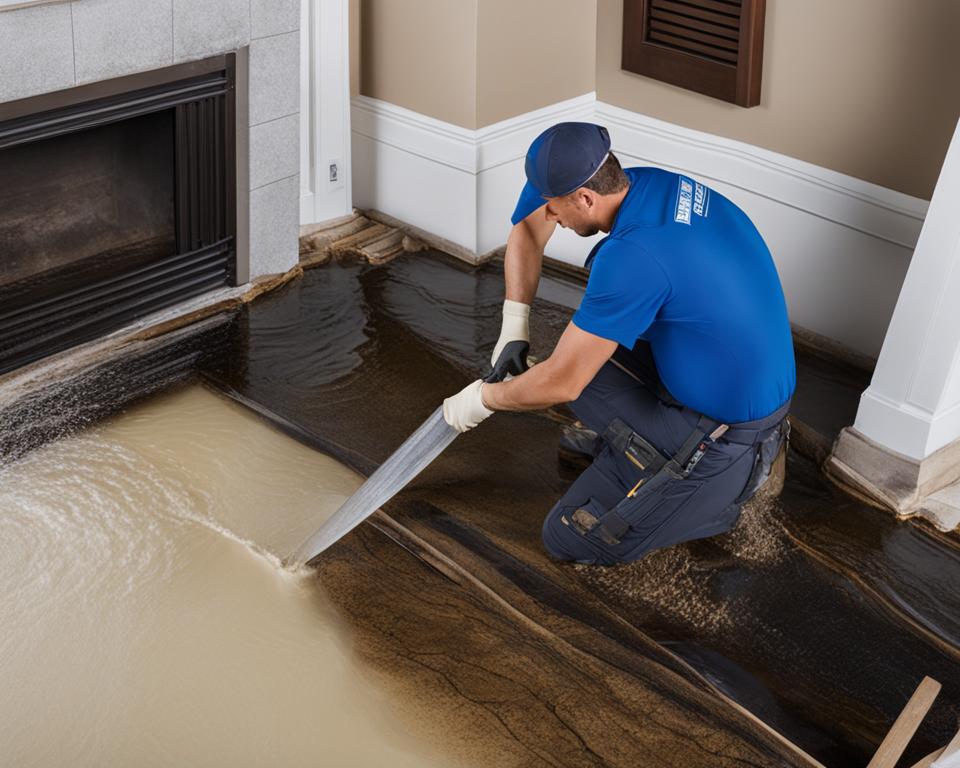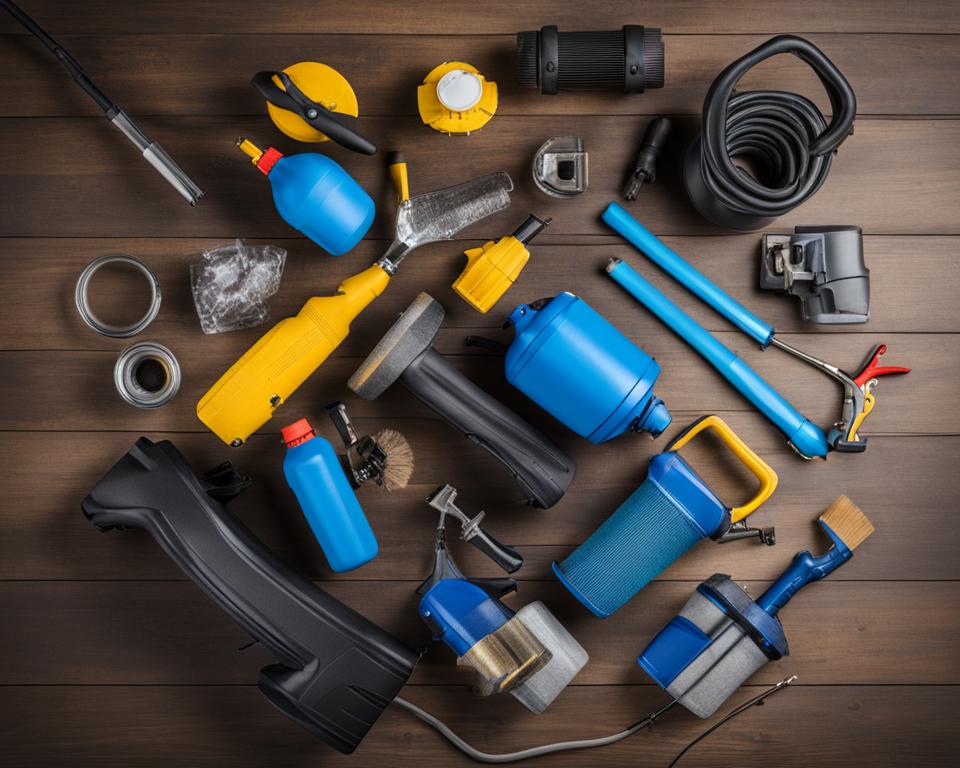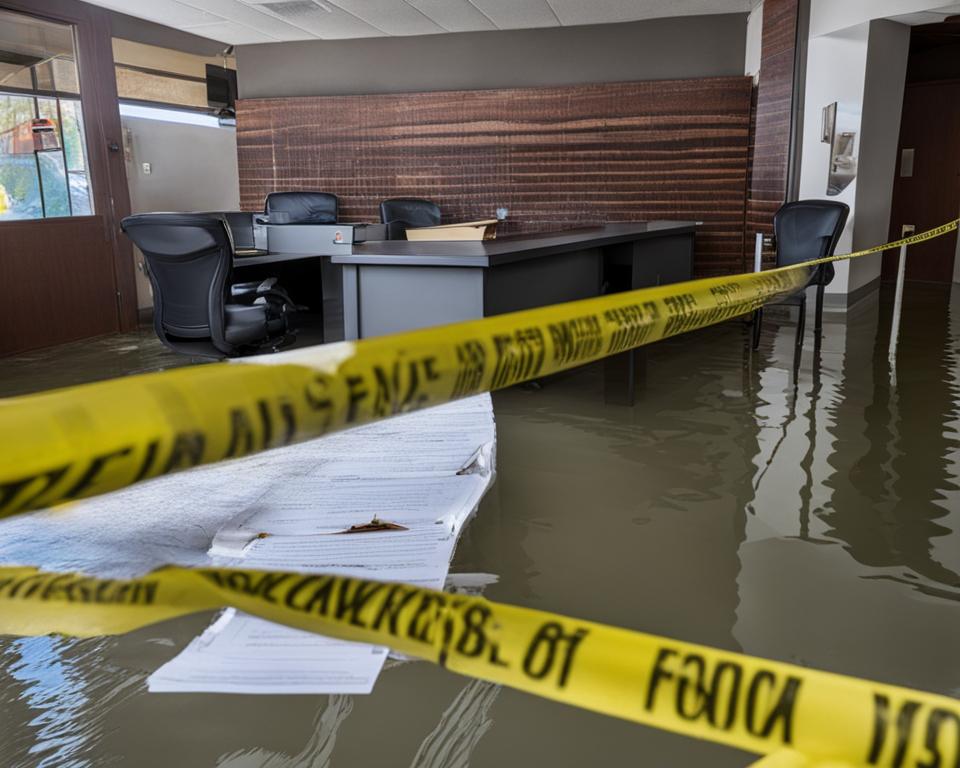Water damage restoration is a crucial process for returning a property to its original state after water intrusion. It involves a range of steps such as inspection, extraction, dehumidification, sanitation, and reconstruction. While certification may not always be mandatory for water damage restoration professionals, it is essential to hire specialists who possess the right tools and knowledge for the job.
Complying with legal requirements is vital in the water damage restoration industry. Understanding water damage regulations and legal obligations is essential to ensure compliance and provide effective restoration services. Governmental bodies have established guidelines and laws that govern the water damage restoration process to safeguard both property owners and professionals in this field.
By adhering to the legal framework for water damage mitigation, professionals can address potential health risks, prevent further damage, and ensure the overall safety of the property and its occupants. Following industry regulations for water damage cleanup not only protects the property but also upholds the reputation and credibility of water damage restoration professionals.
In this article, we will delve into the various laws and regulations that govern water damage restoration, the legal responsibilities of professionals, and the importance of complying with these requirements.
Key Takeaways:
- Water damage restoration is the process of returning a property to its original state after water intrusion.
- Certification may not always be required, but hiring specialists with the right tools and knowledge is crucial.
- It is vital to understand and comply with the legal requirements, guidelines, and industry regulations for water damage restoration.
- Adhering to the legal framework ensures the safety of the property, addresses health risks, and maintains professional credibility.
- In this article, we will explore the laws, legal obligations, and responsibilities related to water damage restoration.
Importance of Water Damage Restoration
Water damage restoration plays a crucial role in safeguarding the structural integrity of a property and protecting the health of its occupants. Ignoring water damage can have severe consequences, leading to further structural damage and creating long-term health risks.
When water damage occurs, it can compromise the stability of walls, ceilings, and floors. Over time, this can result in distorted or collapsed structures, posing a significant safety hazard. Timely restoration is essential to prevent additional damage and ensure the integrity of the property.
Moreover, water damage can create a breeding ground for mold, bacteria, and pests. These harmful organisms thrive in moisture-rich environments and can cause various health issues, ranging from allergies and respiratory problems to infections. By addressing water damage promptly, the risk of these health hazards can be mitigated.
Structural Damage from Water Damage
Water damage, if left untreated, can cause significant structural damage to a property. Here are some common structural issues that can arise from water damage:
- Warped or buckled floors
- Sagging or bulging ceilings
- Cracked or crumbling walls
- Rotted wood and weakened framing
These structural issues not only compromise the safety and stability of the property but also result in costly repairs and reconstruction. Proper water damage restoration helps minimize structural damage and preserve the value of the property.
Health Risks from Water Damage
Water damage can have severe health risks if not addressed promptly and properly. Here are some health hazards associated with water damage:
- Mold growth leading to respiratory issues, allergies, and infections
- Bacterial contamination causing gastrointestinal problems
- Pest infestations attracted to damp environments
- Exposure to toxic substances present in water, such as chemicals or sewage
By engaging professional water damage restoration services, the potential health risks can be effectively mitigated, ensuring a safe and healthy living environment.
Skill and Experience Required for Water Damage Restoration
Proper water damage restoration requires skill, knowledge, and experience to ensure effective and safe recovery. Qualified professionals possess expertise in the following areas:
- Identifying the root cause and extent of water damage
- Implementing appropriate extraction and drying techniques
- Utilizing specialized equipment for thorough cleaning and sanitization
- Repairing and reconstructing damaged areas, if necessary
With their expertise, water damage restoration professionals can address the underlying issues, mitigate potential risks, and restore the property back to its pre-damage condition.
| Key Points | Benefits |
|---|---|
| Prevents further structural damage | Safeguards the property’s stability and value |
| Reduces health risks | Protects occupants from mold, bacteria, and pests |
| Requires skill and experience | Ensures effective and safe restoration |
Major Causes of Water Damage
Water damage can occur due to various sources, leading to significant property damage if not addressed promptly. Understanding the major causes of water damage is crucial for both homeowners and water damage restoration specialists. By recognizing the signs of water damage and addressing the root cause, you can prevent further harm to your property. Here are some of the primary sources of water damage:
- Air conditioning unit condensation: Improper installation or maintenance of air conditioning units can cause condensation, leading to water damage.
- Natural disasters: Severe weather events like floods, hurricanes, and heavy rainfall can result in water intrusion, causing extensive damage.
- Broken household appliances: Malfunctioning or broken appliances such as washing machines, dishwashers, and refrigerators can cause water leaks and flooding.
- Clogged drains and gutters: Accumulated debris and blockages in drains and gutters can cause water to overflow and seep into the property.
- Septic tank and sewer backups: Backups in the septic tank or sewer system can lead to sewage water entering the property, causing significant damage and health hazards.
- Burst or leaking pipes: Aging or damaged pipes can burst or leak, resulting in water damage that can be hidden within walls, ceilings, or floors.
- Old or faulty water heaters: Aging or faulty water heaters can leak or rupture, leading to water damage and potential flooding.
- Damaged sprinkler systems: Faulty sprinkler systems or broken sprinkler heads can cause water to accumulate in unwanted areas, resulting in water damage.
- Water overflow from toilets: Clogs or malfunctions in toilets can cause water overflow, leading to damage to the flooring and surrounding areas.
- Inoperative sump pumps: Sump pumps play a crucial role in preventing water damage by pumping out accumulated water. If the sump pump fails to function properly, it can lead to flooding and property damage.
Water damage restoration specialists should be well-versed in these major causes of water damage. By understanding the sources, they can effectively identify and address signs of water damage. Some common signs include:
- Swollen or warped materials
- Cracks in walls, ceilings, or floors
- Musty odors
- Mold or mildew growth
By promptly addressing water damage and its underlying causes, you can mitigate further damage and ensure a safe and healthy environment in your property.
Water Damage Restoration Process
In order to effectively restore a property after water damage, a comprehensive water damage restoration process is typically followed. This process involves several crucial steps that address the source of the damage, extract water, dry and dehumidify affected areas, clean and sanitize surfaces, and finally repair and reconstruct any damaged areas if necessary. Each step plays a vital role in ensuring thorough restoration and minimizing further damage.
1. Water Damage Inspection
The first step in the water damage restoration process is conducting a thorough inspection to identify the source of the water damage and assess the level of contamination. This inspection helps professionals develop an appropriate restoration plan tailored to the specific situation.
2. Water Extraction
Once the inspection is complete, the next step is to remove standing water from the affected areas. Specialized equipment such as vacuums and pumps are used to extract water efficiently. This step is crucial in preventing further damage and reducing the risk of mold growth.
3. Drying and Dehumidification
After water extraction, the affected areas need to be dried thoroughly to eliminate any remaining moisture. Fans and dehumidifiers are used to facilitate the drying process and minimize the risk of mold and structural damage. Monitoring equipment is also employed to measure humidity levels and ensure proper drying.
4. Cleaning and Sanitizing
Once the affected areas are dry, thorough cleaning and sanitizing procedures are carried out to remove any contaminants, bacteria, and odors left behind by the water damage. This step helps restore a safe and healthy environment for occupants.
5. Repair and Reconstruction
If any structural damage has occurred during the water damage incident, the final step involves the repair and reconstruction of the affected areas. This may include fixing damaged walls, floors, or ceilings, as well as replacing any compromised building materials. The goal is to restore the property to its pre-damage condition.
By following this comprehensive water damage restoration process, professionals can effectively mitigate the damage caused by water intrusion and ensure a successful recovery. The use of specialized tools and techniques at each stage allows for a thorough restoration and helps minimize the risk of further damage or health hazards.

Starting a Water Damage Restoration Business
Starting a water damage restoration business can be a lucrative venture considering the high demand for such services. However, it requires careful planning and attention to various factors to ensure profitability and success. Here are some important considerations when embarking on this venture:
Determine the Types of Services to Offer
Water damage restoration companies offer a range of services, including water extraction, drying and dehumidification, mold remediation, odor removal, and structural repairs. It is essential to determine the specific services your business will offer based on market demand and your expertise. Offering specialized services can help differentiate your business from competitors and attract targeted clientele.
Understand Legal and Licensing Requirements
Before starting a water damage restoration business, familiarize yourself with the legal and licensing requirements in your jurisdiction. Different states or countries may have specific regulations regarding insurance, certification, permits, and bonding. Compliance with these requirements is crucial to operate legally and maintain a professional reputation.
Avoid Common Mistakes
To establish a successful water damage restoration business, it is important to avoid common mistakes that can hinder growth and profitability. Some common pitfalls include underestimating start-up costs, failing to conduct thorough market research, inadequate insurance coverage, improper pricing strategies, neglecting ongoing training and certifications, and insufficient marketing efforts. By learning from the mistakes of others, you can position your business for long-term success.
Promote Business Growth and Efficiency
In order to maximize profitability, focus on strategies that promote business growth and efficiency. This includes building a strong network of industry contacts, investing in state-of-the-art equipment and technology, hiring skilled and certified technicians, implementing streamlined operational processes, and delivering exceptional customer service. By continuously improving and adapting to market trends, your business can stay competitive and thrive in the water damage restoration industry.
| Profitability Factors | Considerations |
|---|---|
| Market Competition | Assess the level of competition in your target market and identify ways to differentiate your services. |
| Location | Choose a location with a significant demand for water damage restoration services, ideally in areas prone to water-related incidents. |
| Pricing Strategy | Set competitive but profitable pricing based on market rates, your costs, and the added value your business provides. |
| Efficient Business Operations | Establish streamlined processes to minimize costs, maximize productivity, and deliver timely and effective services. |
By carefully considering these factors and implementing sound business practices, you can increase the likelihood of success when starting a water damage restoration business. Remember to continuously monitor industry trends, maintain compliance with legal requirements, and provide exceptional service to build a strong reputation in the market.

Preventative Measures for Water Damage
Preventing water damage is crucial for homeowners to avoid costly repairs and potential health hazards. By taking proactive measures, you can significantly reduce the risk of water damage in your property.
Regularly maintaining and cleaning gutters is a vital preventative step. Clearing debris and checking for blockages will ensure proper water drainage, preventing overflow and potential damage to the roof and foundation.
Exterior maintenance is also essential. Conduct thorough inspections for cracks in the walls and foundation, as these can allow water to seep in. Promptly sealing any openings will help keep water out and protect your property.
Don’t overlook the importance of inspecting the basement for leaks and structural issues. Regular basement inspections can identify early signs of water intrusion or existing damages, allowing for timely repairs and mitigation.
Toilets can be a common source of water damage if not properly maintained. Make sure to regularly check and seal any gaps between the toilet and the floor to prevent potential overflow incidents.
Lastly, don’t forget the importance of appliance servicing. Regular maintenance of appliances such as washing machines, dishwashers, and water heaters can help prevent malfunctions that may lead to water leaks or flooding.
By implementing these preventative measures, homeowners can safeguard their properties against water damage, ensuring peace of mind and saving both time and money in the long run.
FAQ
Are there any legal requirements for water damage restoration?
While certification is not always required, it is important to hire a specialist with the right tools and knowledge for effective and safe water damage restoration.
Why is water damage restoration important?
Water damage restoration addresses the cause of water damage and prevents further structural damage. Ignoring water damage can lead to collapsed walls, ceilings, and floors, as well as long-term health risks from mold, bacteria, and pests.
What are the major causes of water damage?
The major causes of water damage include air conditioning unit condensation, natural disasters, broken household appliances, clogged drains and gutters, septic tank and sewer backups, burst or leaking pipes, old or faulty water heaters, damaged sprinkler systems, water overflow from toilets, and inoperative sump pumps.
What does the water damage restoration process involve?
The water damage restoration process typically involves conducting a water damage inspection, extracting standing water, drying and dehumidifying affected areas, cleaning and sanitizing all surfaces, and repairing or reconstructing damaged areas if necessary.
How can I start a water damage restoration business?
To start a water damage restoration business, thorough research and consideration are required. You need to determine the types of services to offer, understand and comply with legal and licensing requirements, and avoid common mistakes to stay ahead of the competition.
What preventative measures can I take to reduce the risk of water damage?
Preventative measures for water damage include regularly cleaning gutters, checking for cracks in the exterior walls and foundation, inspecting the basement for leaks and structural issues, properly sealing toilets, and servicing appliances to prevent malfunctions.

Leave a Reply